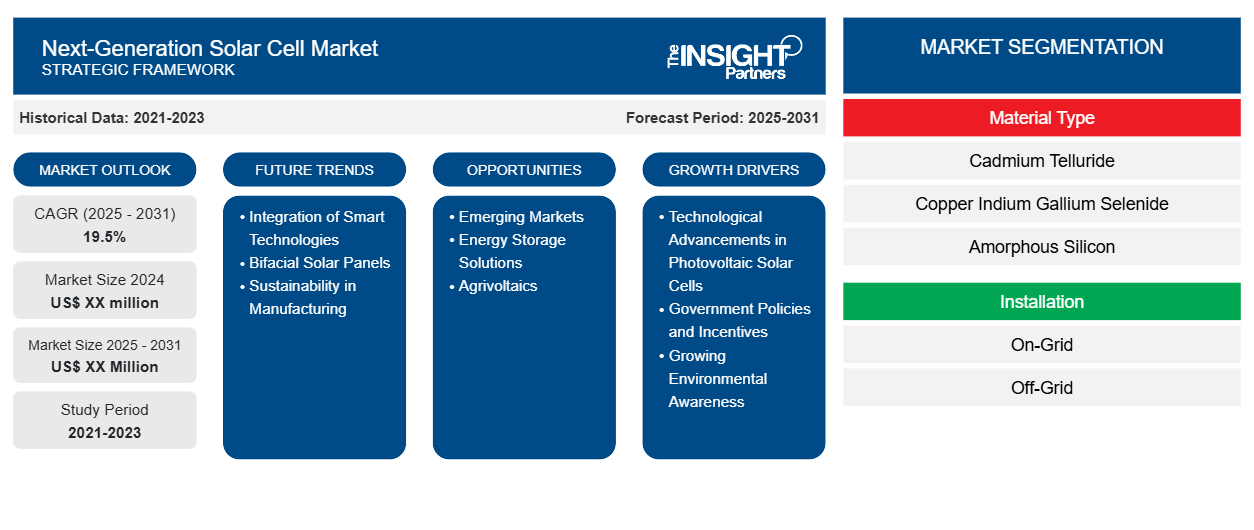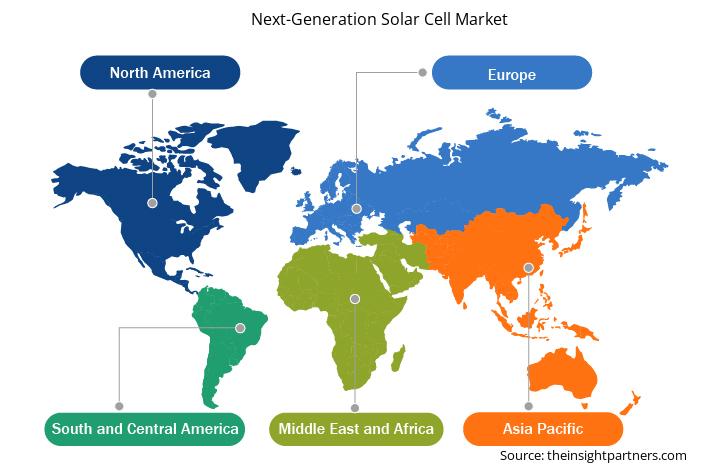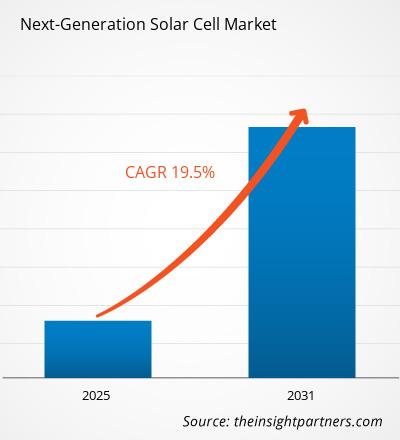2024 年全球下一代太阳能电池市场规模为 41.3 亿美元,预计到 2031 年将达到 129.5 亿美元。预计下一代太阳能电池市场在 2025 年至 2031 年期间的复合年增长率为 15.73%。可持续性和绿色制造可能仍将是市场的主要趋势。
下一代太阳能电池市场分析
受全球清洁能源发展、光伏技术创新以及能源消费模式演变的推动,下一代太阳能电池市场发展势头强劲。市场主要驱动力之一是对高效、低成本太阳能解决方案日益增长的需求。钙钛矿、有机光伏 (OPV) 和串联太阳能电池等下一代技术具有更高的能量转换率、更高的灵活性和更轻量化的设计,使其在从建筑一体化光伏到便携式电子产品等广泛应用领域都具有吸引力。日益增长的环境问题和净零排放承诺正促使各国政府和企业投资先进的可再生能源技术。欧洲、北美和亚太等地区的激励措施、补贴和研发资金正在加速新兴太阳能技术的商业化进程。
下一代太阳能电池市场概览
下一代太阳能电池代表着光伏技术的革新,与传统的硅基太阳能电池板相比,它效率更高、制造成本更低、功能更广泛。这些先进的太阳能电池涵盖钙钛矿电池、有机光伏电池 (OPV)、量子点电池、多结电池和薄膜电池等技术。它们旨在突破传统系统的局限性,在不同光照条件下提供卓越的性能,拥有轻巧灵活的外形,并有可能集成到各种表面和产品中。此外,更低的生产成本和更易扩展的潜力使这些技术具有大规模部署的吸引力。在政府政策和可持续发展指令的支持下,企业正在加大研发投入,并建立战略合作伙伴关系,以实现下一代太阳能解决方案的商业化。随着全球经济转向清洁能源和碳中和目标,下一代太阳能电池被定位为一项战略资产——赋能企业创新、降低能源成本并履行长期环保承诺。
您可以免费定制任何报告,包括本报告的部分内容、国家级分析、Excel 数据包,以及为初创企业和大学提供优惠和折扣
下一代太阳能电池市场:战略洞察

- 获取此报告的顶级关键市场趋势。此免费样品将包括数据分析,从市场趋势到估计和预测。
下一代太阳能电池市场驱动力和机遇
轻量级和灵活解决方案的需求日益增长,市场青睐
随着各行各业寻求将可再生能源融入非传统、移动和空间受限的应用领域,对轻量化和柔性太阳能技术的需求正在快速增长。传统的硅基太阳能电池板刚性、笨重且尺寸有限,这限制了它们在航空航天、汽车、消费电子和建筑等领域的应用。下一代太阳能电池——尤其是薄膜、有机光伏 (OPV) 和钙钛矿基电池——具有显著的优势。这些技术可以在轻质、柔性的基板上制造,例如塑料、玻璃或金属箔,使其成为曲面或移动表面的理想选择。例如,在航空航天和无人机技术中,重量是一个关键因素。超轻太阳能薄膜有助于延长飞行时间并为机载系统供电,而不会增加太多重量。在汽车领域,柔性太阳能电池板正被集成到汽车车顶和车窗中,为电池充电并为车载系统供电,从而支持日益增长的节能电动汽车 (EV) 发展趋势。同样,在消费电子产品中,柔性太阳能材料可以创造能量收集可穿戴设备、传感器和移动设备。
全球能源需求和电气化不断增长
在电动汽车 (EV)、智能家居、工业自动化和城市基础设施不断扩张的推动下,全球电气化转型正在迅速加速。这种转变对清洁、可靠且分散的电力来源产生了前所未有的需求。传统的能源系统通常依赖于化石燃料和集中式电网,越来越难以满足现代经济动态且分布式的能源需求。下一代太阳能技术正在成为应对这一挑战的重要解决方案。与传统太阳能电池板不同,先进的太阳能电池(例如钙钛矿电池、有机光伏电池 (OPV) 和串联电池)效率更高、集成灵活且可扩展,使其成为各种应用场景的理想选择。它们可以部署在屋顶、车辆、基础设施和移动设备上,支持分散式能源模式,从而减少对电网的依赖和传输损耗。
下一代太阳能电池市场报告细分分析
促成下一代太阳能电池市场分析的关键部分是材料类型、安装类型和最终用户
- 根据材料类型,市场细分为碲化镉 (Cdte)、铜印度硒化镓 (CIGS)、钙钛矿、纳米材料和其他。
- 根据安装类型,市场分为并网和离网。
- 根据最终用户,市场分为住宅、商业和工业。
下一代太阳能电池市场份额(按地区)分析
下一代太阳能电池市场报告的地理范围主要分为五个地区:北美、欧洲、亚太、中东和非洲、南美和中美。
2024年,亚太地区占据市场主导地位。在强有力的政策支持、快速的工业化进程以及不断增长的能源需求的推动下,亚太地区正在成为下一代太阳能电池市场的关键增长中心。中国、印度、日本、韩国和澳大利亚等国的政府正在积极投资可再生能源基础设施,以减少对化石燃料的依赖,并实现积极的脱碳目标。尤其是中国,它在全球太阳能制造业中处于领先地位,并正在大力投资钙钛矿和串联电池等先进的太阳能技术,以保持其市场主导地位。印度也在迅速扩大其太阳能产能,为高效、低成本、符合其气候和电网需求的下一代电池创造了机会。与此同时,日本和韩国正在利用有机和薄膜太阳能技术的创新来支持国内能源需求和出口导向型增长。城镇化、电气化程度的提高以及农村和偏远地区对能源获取的追求,正在推动对轻型、灵活和分散式太阳能解决方案的需求。下一代电池是这些应用的理想选择,包括屋顶系统、移动设备和建筑一体化光伏 (BIPV)。此外,该地区强大的电子和汽车产业与先进的太阳能技术形成了天然的协同效应,尤其是在将其集成到电动汽车和消费设备方面。这些因素共同使亚太地区成为下一代太阳能电池市场创新和应用的主要引擎。
下一代太阳能电池市场区域洞察
Insight Partners 的分析师已详尽阐述了预测期内影响下一代太阳能电池市场的区域趋势和因素。本节还讨论了北美、欧洲、亚太地区、中东和非洲以及南美和中美洲的下一代太阳能电池市场细分和地理分布。

- 获取下一代太阳能电池市场的区域特定数据
下一代太阳能电池市场报告范围
| 报告属性 | 细节 |
|---|---|
| 2024年的市场规模 | 41.3亿美元 |
| 2031年的市场规模 | 129.5亿美元 |
| 全球复合年增长率(2025-2031) | 15.73% |
| 史料 | 2021-2023 |
| 预测期 | 2025-2031 |
| 涵盖的领域 | 按材料类型
|
| 覆盖地区和国家 | 北美
|
| 市场领导者和主要公司简介 |
|
下一代太阳能电池市场参与者密度:了解其对商业动态的影响
下一代太阳能电池市场正在快速增长,这得益于终端用户需求的不断增长,而这些需求的驱动因素包括消费者偏好的演变、技术进步以及对产品优势的认知度的提升。随着需求的增长,企业正在扩展产品线,不断创新以满足消费者需求,并抓住新兴趋势,从而进一步推动市场增长。
市场参与者密度是指特定市场或行业内企业或公司的分布情况。它表明特定市场空间内竞争对手(市场参与者)的数量相对于其规模或总市值而言。
下一代太阳能电池市场的主要公司有:
- 韩华Q CELLS
- 牛津光伏
- 钟化太阳能
- 弗利索姆
- 三菱化学集团
- 汉能薄膜发电集团$Heliatek
免责声明:以上列出的公司没有按照任何特定顺序排列。

- 获取下一代太阳能电池市场顶级关键参与者的概述
下一代太阳能电池市场新闻和最新发展
下一代太阳能电池市场评估通过收集一手和二手研究的定性和定量数据进行,这些数据包括重要的企业出版物、协会数据和数据库。以下列出了下一代太阳能电池市场的一些发展情况:
- 韩华系统宣布,其内部合资公司Flexell Space已与空中客车防务与航天有限公司签署意向书(LOI),合作开发采用串联太阳能电池的下一代太空太阳能电池模块。根据该协议,Flexell Space和空中客车计划设计和开发比现有型号重量减轻50%以上,同时保持同等性能和效率的太空太阳能电池模块。(来源:韩华系统,新闻稿,2024年8月)
- Navitas Solar 是一家总部位于苏拉特的印度领先组件制造品牌,年产能达 2 吉瓦。该公司在 2024 年印度国际太阳能展览会 (Intersolar India 2024) 上推出了其最新的下一代 N 型 TOPCon 组件。N 型 TOPCon 技术以其卓越的能量产出和低温度系数而闻名,并可提高太阳能组件的整体效率和使用寿命。(来源:Navitas Solar,新闻稿,2024 年 2 月)
下一代太阳能电池市场报告覆盖范围和交付成果
《下一代太阳能电池市场规模和预测(2021-2031)》报告对以下领域进行了详细的市场分析:
- 下一代太阳能电池市场规模以及涵盖范围内所有关键细分市场的全球、区域和国家层面的预测
- 下一代太阳能电池市场趋势以及市场动态,如驱动因素、限制因素和关键机遇
- 详细的 PEST/波特五力分析和 SWOT 分析
- 下一代太阳能电池市场分析涵盖主要市场趋势、全球和区域框架、主要参与者、法规和最新市场发展
- 行业格局和竞争分析,涵盖市场集中度、热图分析、知名参与者以及下一代太阳能电池市场的最新发展
- 详细的公司简介
- 历史分析(2 年)、基准年、预测(7 年)及复合年增长率
- PEST和SWOT分析
- 市场规模、价值/数量 - 全球、区域、国家
- 行业和竞争格局
- Excel 数据集
近期报告
相关报告
客户评价
购买理由
- 明智的决策
- 了解市场动态
- 竞争分析
- 客户洞察
- 市场预测
- 风险规避
- 战略规划
- 投资论证
- 识别新兴市场
- 优化营销策略
- 提升运营效率
- 顺应监管趋势




















 获取免费样品 - 下一代太阳能电池市场
获取免费样品 - 下一代太阳能电池市场